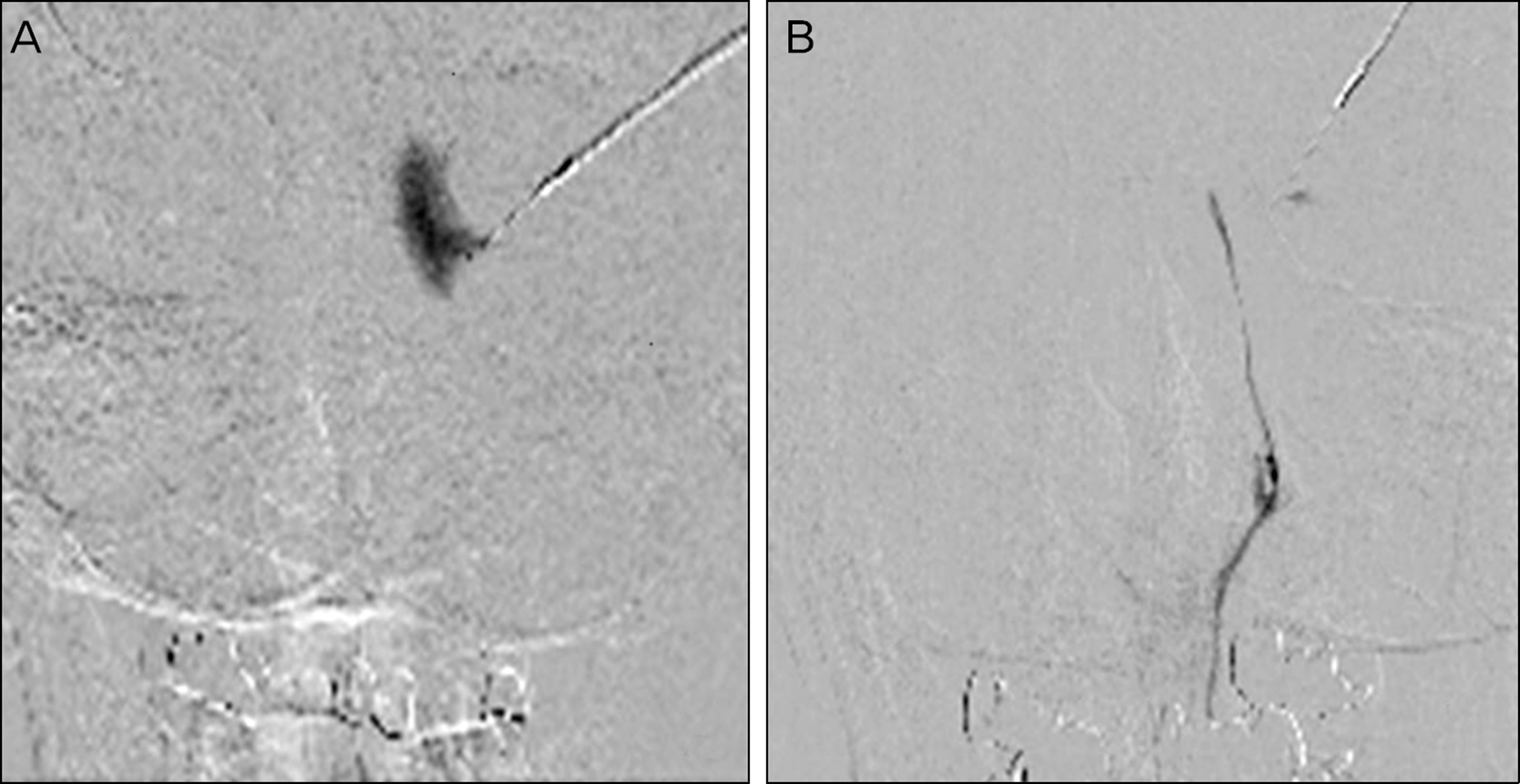J Korean Ophthalmol Soc.
2013 Jun;54(6):845-849. 10.3341/jkos.2013.54.6.845.
Success Rate of Silicone Intubation Between Nasolacrimal Duct Obstruction and Stenosis According to Dacryocystography
- Affiliations
-
- 1Department of Ophthalmology, KyungHee University Hospital, Kyung Hee University School of Medicine, Seoul, Korea.
- 2Department of Ophthalmology, KyungHee University Hospital at Gangdong, Kyung Hee University School of Medicine, Seoul, Korea. pbloadsky@naver.com
- KMID: 2217258
- DOI: http://doi.org/10.3341/jkos.2013.54.6.845
Abstract
- PURPOSE
This study compares the success rate of silicone tube intubation between nasolacrimal duct obstruction and stenosis according to dacryocystographic findings.
METHODS
A total of 115 patients who suffered from epiphora were divided into nasolacrimal duct obstruction and nasolacrimal duct stenosis according to dacryocystographic findings. Silicone tube intubation was performed on every patient. The success rate was estimated based on functional and anatomical success. Functional success was estimated by patient's satisfaction with 'good' or 'fair' at the last visit, and anatomical success was estimated by decrease or normalization of tear meniscus height. Surgery success was defined when anatomical and functional successes were fulfilled.
RESULTS
Success rate of silicone tube intubation was 75.76% for patients with nasolacrimal duct obstruction based on dacryocystography, and 86.59% for patients with nasolacrimal duct stenosis based on dacryocystography; the difference was not statistically significant (Pearson chi-square test, p = 0.693).
CONCLUSIONS
Silicone tube intubation can be considered as a primary treatment option for management of epiphora in nasolacrimal duct stenosis and obstruction.
MeSH Terms
Figure
Cited by 1 articles
-
The Clinical Outcome of Silicone Tube Intubation According to the Site Resistant to Lacrimal Duct Probing
Chan Min Yang, In Ki Park
J Korean Ophthalmol Soc. 2015;56(7):975-979. doi: 10.3341/jkos.2015.56.7.975.
Reference
-
References
1. Jeffrey JH, Myron Y, Jay SD. The lacrimal drainage system. Ophthalmology. 1999; 7:71–8.2. Kim JH, Kim JM, Woo KI. The role of dacryocystography in eval-uation of nasolacrimal duct obstruction. J Korean Ophthalmol Soc. 2006; 47:1713–9.3. Kim JS, Ahn M. Clinical evaluation and classification of nasolacri-mal duct obstruction site by dacryocystography. J Korean Ophthalmol Soc. 2005; 46:191–5.4. Rosengren B. On lacrimal drainage. Ophthalmologica. 1972; 164:409–21.
Article5. Park WH, Kim MJ, Choi YJ, Kim SJ. The clinical study of lacrimal sump syndrome after endonasal dacryocystorhinostomy. J Korean Ophthalmol Soc. 2005; 46:1089–94.6. Lee HS, Lew H, Yun YS. Classification of nasolacrimal duct ob-struction according to dacryocystographic finding and its clinical significance. J Korean Ophthalmol Soc. 2003; 44:1475–82.7. Hong JH, Chung WS. The surgical efficacy of external dacryo- cystorrhinostomy. J Korean Ophthalmol Soc. 2001; 42:547–52.8. Hurwitz JJ. The lacrimal system. 1st ed. Philadelphia: Lippincott- Raven;1996; 117–22.9. Gupta PD, Johar K Sr, Nagpal K, Vasavada AR. Sex hormone re-ceptors in the human eye. Surv Ophthalmol. 2005; 50:274–84.
Article10. Soll DB. Silicone intubation: an alternative to dacryocystorhino- stomy. Ophthalmology. 1978; 85:1259–66.11. Pashby RC, Rathbun JE. Silicone tube intubation of the lacrimal drainage system. Arch Ophthalmol. 1979; 97:1318–22.
Article12. Anderson RL, Edwards JJ. Indications, complications and results with silicone stents. Ophthalmology. 1979; 86:1474–87.
Article13. Lee SH, Kim SD, Kim JD. Silicone intubation for nasolacrimal duct obstruction in adult. J Korean Ophthalmol Soc. 1997; 38:185–9.14. Sohn HY, Hur J, Chung EH, Won IG. Clinical observation on sili-cone intubation in obstruction of lacrimal drainage system. J Korean Ophthalmol Soc. 1990; 31:135–40.15. Mäntynen J, Yoshitsugu M, Rautiainen M. Results of dacryocysto-rhinostomy in 96 patients. Acta Otolaryngologica. 1997; 529:187–9.
Article16. Weidenbecher M, Hosemann W, Buhr W. Endoscopic endonasal dacryocystorhinostomy: results in 56 patients. Ann Otol Rhinol Laryngol. 1994; 103:363–7.
Article17. Jin SW, Ahn HB, Kim MH. Long-term results of silicone tube in-tubation in patients with common canalicular stenosis. J Korean Ophthalmol Soc. 2012; 53:1373–7.
Article18. Ruby AJ, Lissner GS, O'Grady R. Surface reaction on silicone tubes used in the treatment of nasolacrimal drainage system obstruction. Ophthalmic Surg. 1991; 22:745–8.
Article19. Angrist RC, Dortzbach RK. Silicone intubation for partial and total nasolacrimal duct obstruction in adults. Ophthal Plast Reconstr Surg. 1985; 1:51–4.
Article20. Fulcher T, O'Connor M, Moriarty P. Nasolacrimal intubation in adults. Br J Ophthalmol. 1998; 82:1039–41.
Article21. Connell PP, Fulcher TP, Chacko E. . Long term follow up of na-solacrimal intubation in adults. Br J Ophthalmol. 2006; 90:435–6.
Article22. Demirci H, Elner VM. Double silicone tube intubation for the man-agement of partial lacrimal system obstruction. Ophthalmology. 2008; 115:383–5.
Article23. Aritürk N, Oge I, Oge F. . Silicone intubation for obstruction of the nasolacrimal duct in adults. Acta Ophthalmol Scand. 1999; 77:481–2.
Article24. Migliori ME, Putterman AM. Silicone intubation for the treatment of congenital lacrimal duct obstruction: successful results removing the tubes after six weeks. Ophthalmology. 1988; 95:792–5.
Article25. Peterson NJ, Weaver RG, Yeatts RP. Effect of short-duration sili-cone intubation in congenital nasolacrimal duct obstruction. Ophthal Plast Reconstr Surg. 2008; 24:167–71.
Article
- Full Text Links
- Actions
-
Cited
- CITED
-
- Close
- Share
- Similar articles
-
- Silicone Intubation and Dacryocystographic Finding in Incomplete Nasolacrimal Duct Obstruction
- Classification of Nasolacrimal Duct Obstruction According to Dacryocystographic Finding and Its Clinical Ssignificance
- Treatment of Congenital Nasolacrimal Duct Obstruction Using Silicone Intubation Set
- Results of Silicone Tube Intubation in Patients with Common Canalicular Obstruction in Dacryocystography
- Comparison of Results and Complications between 0.64 mm and 0.94 mm Silicone Tube Intubation in Adults


